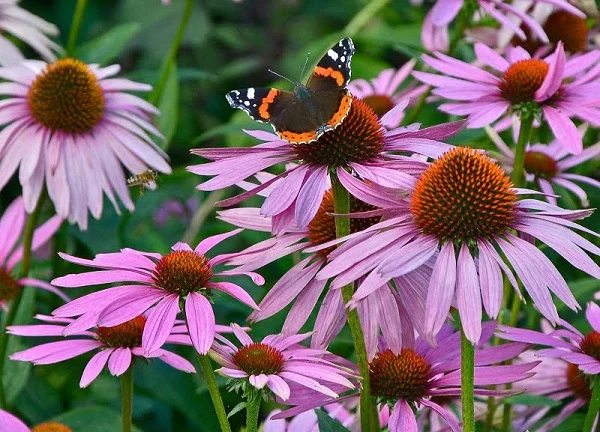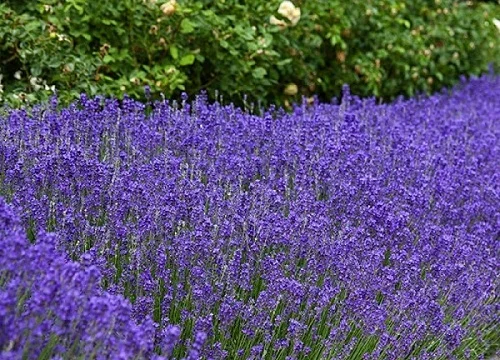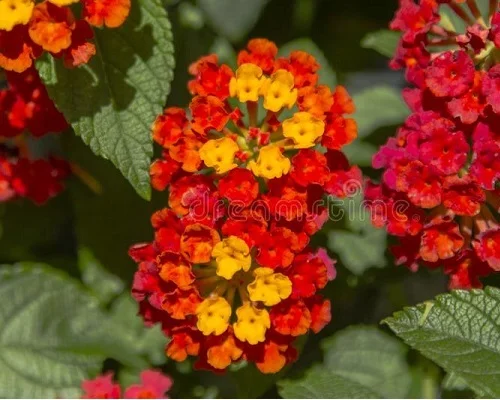How to Grow and Care for Purple Coneflower | Echinacea purpurea Care
Some links in this post may be affiliate links
Purple Coneflowers are heat and drought-tolerant, long blooming, self-seeding, herbaceous, perennial plants which bear a large rounded flowerhead with a light, sweet, honey-like fragrance.
The flowerhead also called a capitulum is a composite of several much smaller flowers and its function is to attract pollinators. The name, 'coneflower' is in reference to the flowerhead’s raised cone-like center.
The stems are upright and unbranched. The leaves are hairy with a rough texture and are arranged alternately on the stem.
Purple Coneflower is resistant to deers; the spicy flower centers and strong aromas may deter deers but a hungry deer will eat them nonetheless. Rabbits, squirrels and woodchucks also eat these plants.
Echinacea purpurea belongs to Asteraceae (Daisy) family. The genus name, Echinacea, comes from Greek 'ekhinos' which means 'sea urchin', in reference to the spiny central disk of the flowerhead.
There are about nine species in the genus which are grouped together as coneflowers where Purple Coneflower is one of the most common and popular plants on account of its hardiness.
The species name, 'purpurea', means 'reddish purple', in reference to the color of the flowerhead which appears reddish purple.

Botanical name: Echinacea purpurea
Synonmy: Rudbeckia purpurea
Family: Asteraceae
Common names: Purple Coneflower, Eastern Purple Coneflower, Hedgehog Coneflower, Broad-leaved Purple Coneflower, Echinacea
Origin
Purple Coneflower is native to central and eastern United States of America, in the moist to dry prairies and open wooded areas. It bears a fibrous root system which enables it to tolerate garden growing conditions better than other native plants. They are ideal for USDA Zones 3-9.
Flowers
The inflorescence in Purple Coneflower is a composite flower comprising of a compact arrangement of ray and disk florets. It blooms from early summer to mid-fall. The flowers are attractive to butterflies, bees, hummingbirds and songbirds.
Size
Purple Coneflowers size ranges from 2-5 feet high and 1.5-2 feet wide.
Purple Coneflower Care
Purple Coneflowers thrive in full sun with at least 6-8 hours of sunshine per day, warm, dry conditions and well-drained soil that is rich in organic matter to promote a lush growth.
Echinacea purpurea cannot tolerate excessively humid conditions and rainy, wet areas. Pruning is necessary to keep the plant neat, to control growth, to encourage flowering and to minimize pest and disease infestations as it improves aeration.

Light Requirements
Purple Coneflowers require full sun with at least 6-8 hours of sunshine per day through out the growing season. It can tolerate some shade but too much shade will cause the plants to become floppy and it may also encourage powdery mildew infestations.
Water Requirements
In the first growing season after planting, water the young Purple Coneflowers regularly to maintain the soil moist until the plants are well established.
Once established, the plants are fairly drought-tolerant and will not require very frequent watering. Water the established plants moderately during the growing season while allowing the soil dry out between waterings.
Temperature and Humidity
Purple Coneflowers can withstand a wide range of temperatures but they cannot tolerate wet and very humid conditions. Avoid growing the plants in wet, rainy areas.
Fertilizer
Purple Coneflower will not thrive with synthetic fertilizers. At planting time, incorporate a handful of manure into the planting hole. Thereafter, add a 2 inches layer of manure around the plant every spring.
This should be adequate and no more feeding is required. Avoid excessive feeding as it may result in vegetative growth at the expense of flower production.
Soil
The best soil for Purple Coneflower should be loamy soil, rich in organic matter and one that drains easily to prevent it from holding excess water.
Echinacea purpurea grow best in a neutral PH btween 6.5 -7.0. If the soil is too acidic add lime as acidic soil can lead to the death of the plant.
If the soil is clay add some sand and manure to the soil to enhance drainage and add manure in sandy soil to encourage water retention.
Where to Buy Purple Coneflowers
Purple Coneflowers plants and seeds are readily available online. Below are our recommendations.
- Purple Coneflowers plants and seeds are available on Etsy (Link to Etsy)
- Purple Coneflowers seeds are available on Amazon (Link to Amazon)
Starting Purple Coneflower Seeds
Purple Coneflower seeds require cold stratification (chilling) before sowing to break dormancy; plant the seeds in damp seed starting mix and place the container in a refrigerator for 8-10 weeks.
Indoors, start the seeds at least 6-8 weeks before the last frost. Alternatively sow the seeds outdoors in fall to allow for the chilling to take place in winter.
Sow the seeds about 1/4 inch deep and cover with soil as they require darkness to germinate. Germination should occur in 1-2 weeks.
Where to Plant Purple Coneflowers
Plant Purple Coneflowers along walkways and garden paths. It can also be planted in mass borders, in flowerbeds and groupings.
When to Plant Purple Coneflowers in the Ground
The best time to plant Purple Coneflowers in the ground is in spring after the threat of frost has passed and the soil has warmed up enough.
Planting Purple Coneflowers in the Ground
Dig up the soil to a depth of about 12-18 inches to loosen it and get rid of all the weeds and other debris from the soil.
Prepare planting holes twice as wide as the rootballs at a spacing of 12-24 inches. Incorporate a handful of fully decomposed organic manure per hole.
Plant the Purple Coneflowers at the same depth as they were in their pot. Firm the soil around the root ball lightly.
Thoroughly water the plants and maintain the soil moist until the plants are well established. Thereafter, water moderately while allowing the soil to dry out between waterings.
Apply a thin layer of compost on the soil surface and then a mulch to keep the soil moist and discourage growth of weeds.
Repotting Container-grown Purple Coneflowers
Where the conditions are not favourable for growing Purple Coneflowers in the ground like in areas with harsh winters, you can grow the plants in containers.
Doing so allows you to move the plants to sunny spots during summer for the much needed sunlight and indoors next to a sunny window when the conditions are harsh in winter.
Repot Purple Coneflower at the beginning of the growing season (spring). Use a pot that is large enough to accomodate the roots.
Confirm that the container has adequate drainage holes to prevent the soil from getting soggy to prevent root-rot and eventual loss of the plant.
Select a clay or terracotta pot rather than a plastic or ceramic pot as a clay pot is porous and allows the soil to dry out faster to keep it from staying wet for too long.
Slip the plant out of its nursery pot and place it in the center of the container at the same soil level as it was in the previous pot and back fill with fresh, loamy soil that is rich in organic matter.
Do not fill the pot completely but allow a space of about 1 in. from the rim for watering purposes to avoid spillage.
Wet the soil thoroughly until water comes out through the drainage hole(s). Thereafter, water moderately during the growing season when the top 2-3 inches of soil dry out. Reduce watering in the cold season (winter).
Pruning Purple Coneflower
Pruning Purple Coneflower involves cutting back the stems to ground level once flowering is over to overwinter the plants. Cutting back promotes new growth from which the flower buds emerge.
Remove spent flower to keep the plant neat and tidy, to discourage pest and disease infestations as well as encourage more blooms and prevent reseeding.
Cut back the stalk to the leaf near a new flowerbud or a set of leaves. Use a sharp, sterilized scissors as Purple Coneflower is too thick to snip the flowerstalk with the fingers.
However, for reseeding purposes, allow some flowerheads to seed. This will also provide food for the birds in addition to having the plants growing in different locations in your garden.
Propagation
Purple Coneflower (Echinacea purpurea) can be propagated by plant division at the beginning of the growing season (spring) or in fall after flowering.
How to propagate Purple Coneflower by Plant Division
With age, Purple Coneflowers become overcrowded and root-bound which decreases flowering. To keep the plants vigour, divide them every 3-4 years.
Carefully dig up the plants and split the clumps into several sections while ensuring that each section has adequate roots to hasten establishment.
Plant these sections in individual holes at the same depth that they were previously to avoid rotting and death of the plant.
Water the new plants thoroughly and maintain the soil moist through out until they are well-established after which you can begin routine care.
Uses of Purple Coneflowers
The roots, leaves and flowering tops have been used in herbal medicine for treatment of common cold, coughs, bronchitis and upper respiratory infections.
Dried flowerbuds can be used in herbal teas to strengthen immunity.
The flower heads can be used as cuflowers as the petals expand but the vase-life is only 5-7 days.
Companion Plants
Some of the best companion plants for Purple Coneflowers create include Black-eyed Susan, Shasta Daises, Russian Sage, Phlox among others.

Purple Coneflower Problems
Purple Coneflower (Echinacea purpurea) is a hardy plant and has few problems, some of which include;
Diseases
Common diseases in Purple Coneflowers include;
- Leaf Spot: Appears as small circular spots on the leaves and is prevalent in poorly aerated, overdamp conditions.
- Aster Yellows: Characterized by deformed flowers, yellow leaves with green veins and spread by sap-sucking insects like leafhoppers.
- Powdery mildew: Appears as white or gray powder-like substance on the leaves and the stems. It is prevalent in damp, poorly ventilated conditions.
- Botrytis (Black Mold): Characterized by gray, fluffy mould which can cover all parts of the plant including leaves, stems, buds and flowers.
- Root-rot: Which is common in container-grown plants and plants grown in poorly drained soils as soggy soil enhances the growth of the causative fungi.
Do not overwater the plants or let them sit in soggy soil. Ensure that the soil is free-draining and water only when the soil has dried out.
For container-grown plants, make sure that the container has adequate drainage holes and that the soil is drains easily.
Avoid overcrowding of the plants and also prune some of the branches to improve the ventilation and ensure that there is good air circulation at all times.
The disease has no cure. Dig up the plant immediately and destroy it to minimize spread to the rest of the plants.
Avoid overwatering and ensure that the soil is well-drained. Do not wet the foliage during watering and make sure that there is good air circulation. Position the plant in a sunny spot where it will receive 6-8 hours of sunshine daily.
It is caused by the fungus, Botrytis cinerea and is prevalent where the growing conditions are cool and humid with no air circulation.
Cut all affected parts of the plant and destroy by burning to prevent spread to the entire plant and other plants. Spray the plant with a systemic fungicide. Ensure all the parts of the plant are well covered with the fungicidal solution.
Maintain the soil on the drier side; reduce watering to keep the soil moderately moist, improve ventilation and do not wet the foliage.
For container-grown plants; Take out the plant from its pot and inspect the roots. Mushy brown-black roots are indicative of root-rot. Cut away the infected roots. Spray the healthy roots and the entire plant with a copper-based fungicidal solution.
Repot the plant in a fresh pot and fresh, well-drained soil. Ensure that the pot has adequate drainage holes. Position the plant in a sunny spot. Do not water and keep the soil dry for a few days.
For plants grown in the ground; Uproot and destroy the affected plant. Dig up the surrounding soil and discard it. Spray the surrounding soil with a copper-based fungicidal solution to minimize spread of the disease to the rest of the plants.
Pests
Common pests in Purple Coneflower are aphids, leafhoppers, leaf miners, vine weevils and Japanese Bettles. Spray the plant with an insecticidal soap or neem oil to get rid of the pests. Make sure to follow the manufacturer's recommendations.
You liked it? Share on social media.
Related Content
Amazon Associates Disclosure
Homeplantsguide.com is a participant in the Amazon Services LLC Associates Program, an affiliate advertising program designed to provide a means for sites to earn advertising fees by advertising and linking to amazon.com.


